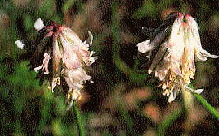

Summer Clover
Trifolium longipes Nutt.
Perennial herb with branched rhizomes and a taproot. The
stems spread to erect, up to 21 inches long, smooth or with some appressed
hairs. Leaves alternate, divided into 3 leaflets; each leaflet narrow,
lanceolate to obovate, pointed or rounded at the tip, tapering to the base, up
to 2 inches long, finely toothed, hairy on lower surface; leaf stalks longer
than the leaflets. Flowers are crowded into ovoid heads up to 2/3 inch across,
on long stalks up to 6 inches long. There are 5 sepals, united below into a
tube, 1/3 to nearly 1/2 inch long, the slender teeth longer than the tube, hairy
with 5 white petals (less commonly pinkish), arranged to form a sweet pea-shaped
flower 1/3-1/2 inch long. There are 10 stamens and ovary, superior, hairy
pistils. This clover has ovoid heads of white (less commonly pinkish) flowers
and leaves on stalks longer than the leaflets. The petals of this species
sometimes also may be tinged with purple. The fruit pods are a little longer
than broad, hairy near the tip, containing 2-4 seeds.
The plant flowers from June-September. It is found in wet meadows in the
mountains, yellow pine forests, and red fir forests, throughout the Rocky
Mountain areas between 4000 and 6000 feet and Western U. S.
Food Use:
It is edible raw, but may cause bloat in large amounts. To
avoid this effect, the leaves may be steamed or cooked or soaked for several
hours in salt water. Prepared in these ways, clover makes an excellent protein
supplement. The prepared leaves may be dried and stored for future use. A tea
can be made from the dried flower heads. The seeds are also edible.